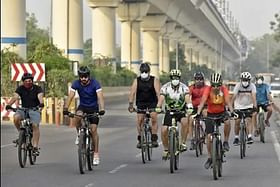Despite the growing interest in cycling in India, this mode of transportation still has a long way to go before it becomes a dependable option for urban populations.
In Mumbai, the recent operations of the metro has opened up bicycle sharing options with its infrastructure installed at various metro stations to offer cycling for last-mile connectivity.
The bicycle sharing facility along Mumbai Metro Line 2A and 7 stations has seen an uptick in this service.
The Mumbai Metropolitan Region Development Authority (MMRDA) collaborated with a private bicycle service provider, MYBYK, for setting up the arrangements for this service at various metro stations.
According to the cycle service provider, 351 bicycles have been deployed at 28 stations, of which users have subscribed to 176 bicycles and 175 bicycles are available at the hubs currently.
From an average 300 users a month before the metro phase two, more than 320 additional users were recorded in just eight days time after inauguration of the entire corridor.
Similar examples of bike sharing and cycling opportunities have also come up in other cities.
Delhi Metro Rail Corporation (DMRC) made attempts to enhance last-mile connectivity for its users through a bicycle renting system setup at select stations.
Further, DMRC partnered with Yulu to offer electric bikes at a total of nine metro stations in the city.
Delhi is among the first few Indian cities to introduce a cycle-sharing system. However, these initiatives never reached a successful model to see increased number of cycle users on the city streets.
With the growing interest of users and options to avail this mode, the supporting infrastructure also requires utmost attention in planning and development. This includes better cycling lanes, safety measures, traffic rules and management.
These remain the key aspects to support the growth trajectory — for not just the cycle sharing model, but also for the overall cycling culture in cities which includes livelihood cyclists, hobby cyclists and people seeking to make use of cycle for their daily commute.
Present Condition Of Cycling Infrastructure In Indian Cities
Even with a number of initiatives rolled out in Mumbai, including the recent bike sharing availability at metro stations, the city still lacks infrastructure for lanes, parking and traffic management which makes it unsafe for cyclists on the roads.
Cycling in Mumbai becomes difficult without a seamless network of dedicated tracks. It becomes difficult to be accommodated safely with most of the narrow roads and footpaths being congested, with not enough space even for pedestrians.
In Delhi, cyclists struggle to navigate the roads due to poor road infrastructure. Despite efforts by the Public Works Department (PWD) to create cycle lanes on the streets, these markings often disappear quickly, leaving cyclists vulnerable among the heavy traffic of motor vehicles.
Cars and motorcycles are often parked on roads, further complicating the conditions.
In many service lanes of Dwarka sub-city, patchy markings indicate the cycling areas which covers half of the lane that also serves for two-way motor traffic, creating a clutter for the existing traffic and also the cyclists.
A recent study by Indian Institute of Technology (IIT), Delhi, has found that cyclists in the city may be travelling shorter distances than other commuters, but their estimated “fatality risk” per kilometre is more than two times than that of people on motorcycles and around 40 times higher than that of car occupants.
As per reports from Bangalore, citizens consider cycling to be dangerous in the city due to a lack of well-maintained cycle lanes. At many places, entry points to cycle tracks have been blocked by poles and cables, while for some lanes, bollards to segregate from main roads have been removed.
The cyclists feel the overall number of tracks available remains insufficient to enable them to pedal without running into traffic or pedestrians.
Chennai has a thriving community of cycling enthusiasts. Despite this, many of the hobby cyclists say the infrastructure required to convert a weekend ride into an everyday means of transportation is far from adequate.
Currently, only a few roads in the city have designated cycle lanes, which are marked with paint. However, these lanes are also often encroached upon by motorists due to the lack of physical barriers to separate them.
Chandigarh has a vast network of over 200 km of bike lanes covering much of the city. However, problems with inadequate maintenance and poor connectivity between different sections of these lanes remain a persistent challenge for cyclists. At some places encroachments have come right next to cycle tracks restricting their movement.
Approach Towards ‘Leisure’ Or A ‘Reliable Mode Of Transport’
The infrastructure in the cities today for cycling have brought up many similar issues due to which the mode is still avoided by users.
In Indian cities, cycling can be seen in more than one way.
India has a large number of livelihood cyclists, as a large population is dependent on cycle as a means for their daily mobility within the city.
Additionally, cycling has been emerging in the urban cultures for its purpose of leisure, sports, health and in relation to growing environmental consciousness.
Most of the cycling infrastructure we see today developed in fragments, which lacks the vision and push to making it into a mass utility model for Indian cities.
With no long connectivity and organised lanes, the fragmented infrastructure remains as an accessory and a cosmetic development in the current city infrastructure.
Despite the growing interest in cycling in India, this mode of transportation still has a long way to go before it becomes a dependable option for urban populations.


